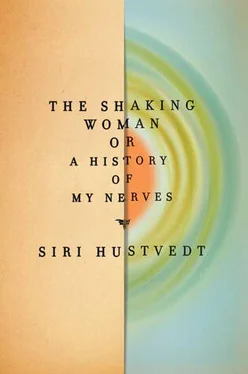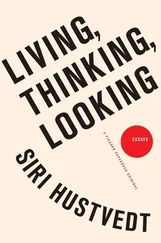I CONTINUED TO SHAKE. I shook even with lorazepam, but not at every public appearance, only some. When my last novel was published, the one narrated by my imaginary brother, in which I used parts of the memoir my father had written for his family and friends, and I read sections from it aloud to audiences, I shook. When I found myself on a panel in Australia discussing death in literature, I shook. The story always played out the same way. If I kept talking, the shudder would subside, but it takes great control not to be distracted by a violent convulsion of your own body, and I began to wonder if I could bear up. What had once taken me by surprise became familiar. What had seemed a bizarre occurrence with no conscious identifiable emotion connected to it began to look more and more like an extreme form of stage fright — entirely irrational but exclusively connected to moments when I was exposed to public scrutiny. Everything associated with performance made me anxious and distressed. At any moment, the unruly saboteur inside me might appear and disrupt the proceedings. It was then that I discovered the beta-blocker Inderal. Years ago, I’d taken Inderal for migraine. It had done no good for the headache, but on the advice of a friend I tried 10 milligrams of the drug before readings or talks, and it worked . Inderal (or propranolol) is a blood pressure medicine; an adrenoceptor blocker, it shuts down the release of stress hormones.
One would imagine that my narrative of the shaking woman ends here, that the successful elimination of my seizures during events in front of strangers would have filled me with relief, perhaps even joy, but that is not what has happened. While I was on a tour in Germany and Switzerland, I popped propranolol before every reading in the six cities I visited and had no tremor. In the last city, Zurich, I took the pill and read without shaking, but I felt the quiver internally throughout the event, an electric buzz running up and down my limbs. It was like shaking without shaking. While I read, I scolded myself internally, saying repeatedly, “Own this. This is you. Own it!” Of course, the fact that I spoke to myself in the second person suggests the split that had taken place — a grim sense that two Siris were present, not one. By then, I was exhausted from traveling from one city to another, from giving interviews and readings every day, from relentless anxiety about shaking, and from offering up deep parts of my inner life to others in the form of readings from a book that had come directly out of my father’s death. While a pharmacological solution inhibited the outward problem, it didn’t solve the mystery. It did not tell me what had happened.
Beta-blockers have been used to treat heart disease, anxiety, glaucoma, hyperthyroidism, and neurological problems such as migraine. In Basic and Clinical Pharmacology, under a section titled “Neurologic Diseases,” the authors admit that they do not know why propranolol is sometimes effective for migraine. They go on to say, “Since sympathetic activity may enhance skeletal muscle tremor, it is not surprising that beta antagonists have been found to reduce certain tremors. The somatic manifestations of anxiety may respond dramatically to low doses of propranolol especially when taken prophylactically. For example, benefit has been found in musicians with performance anxiety (‘stage fright’).” 32(My italics.) “Sympathetic activity” is a part of the autonomic nervous system, the part of us that goes into high gear during an emergency or a stressful situation. It is automatic and involuntary. All this fits my case, but why did I, without any warning, suddenly come down with stage fright when I was fifty-one years old? For some reason, after many years of relative calm, I developed not just the easily hidden, nervous tremor I had experienced before, but huge, near-toppling spasms. And why didn’t I feel anxiety before my first bout of shakes if it was related to anxiety? Why can I speak calmly through every seizure? Where is the heart-thumping, breathless feeling of panic I have experienced in other situations?
PROPRANOLOL IS ALSO USED to treat the repetitive debilitating memories of post-traumatic stress disorder. It doesn’t eliminate the memories; rather, it decreases their intensity and makes them more bearable. The cognitive scientist Larry Cahill conducted a research study that demonstrated the effects of the drug on memory. Two groups of people were shown a series of slides that in the beginning were identical. Everyone saw the same first four slides, but then the narrative diverged into either a neutral story (a boy and his parents visit a hospital and watch emergency drill procedures) or an emotionally arousing story (the boy is badly injured in an accident and is rushed to the hospital, where the surgeons reattach his severed feet). 33Before watching one of the two stories, subjects were given either propranolol or a placebo. Two weeks later, the participants were told to return, but they were not informed that their memories for the slides would be tested. The results showed that subjects who had taken the placebo had enhanced memory for the accident story, but those who took propranolol did not. People tested about the same for the neutral slides. When we have strong emotional experiences, the stress hormones epinephrine (adrenaline) and cortisol are released in our brains and appear to act as stimuli for keeping memories alive. Propranolol, however, interferes with the release of those hormones and blocks the effect emotional excitement has on recollection. It seems, however, to have no influence on people’s ordinary or more neutral memories. 34
Emotional memories also appear to be processed and stored differently in the brain from more pedestrian memories, which may explain the phenomenon of traumatic flashbacks. A neurobiological study conducted in 1996 on people who experienced flashbacks concluded that these memories are “organized on a perceptual and affective level with limited semantic representation and tend to intrude as emotional or sensory fragments related to the original event, with stability over time.” 35This is an elaborate way of saying that what returns in a flashback is remembered not through language but through emotion and sensation. After a car accident, I had flashbacks four nights in a row. Each time I was asleep, and each time I woke sitting up in bed, terrified, my heart racing, after reliving the moment of the crash: the speeding van, the deafening noise of glass and metal exploding around me. For four nights in a row, I relived the shock of that van as it slammed into the passenger side of the car, where I was sitting. These were not like any memories I have ever had. I had not sought them, and they had not been triggered by some external stimulus — a smell or taste or sight or sound. They just came, and when they came, they were not in the past but in the present. The thing that had happened, happened again.
IN HISTORY BEYOND TRAUMA , Françoise Davoine and Jean-Max Gaudillière, two psychoanalysts who have done extensive work in the field, address this curious alteration of time among those who have been traumatized. “ ‘Once upon a time,’ ” they write, “becomes ‘Once upon no time.’ ” 36Trauma memory has no narration. Stories always take place in time . They have a sequence, and they are always behind us. Those four nights of reenactment were wordless. I could not say, Oh, yes, that happened four days ago when my husband, daughter, our dog, and I were driving home from the country. A speeding van hit us at an intersection. The car was completely destroyed, but we all survived . The experience had no context (returning from the country), no place (where Third Street and Fourth Avenue in Brooklyn cross), and was in no way diminished by distance (it isn’t happening now; it happened yesterday or the day before or the day before that). The violence burst into my sleep from nowhere and shocked me with the same force as the accident itself.
Читать дальше












